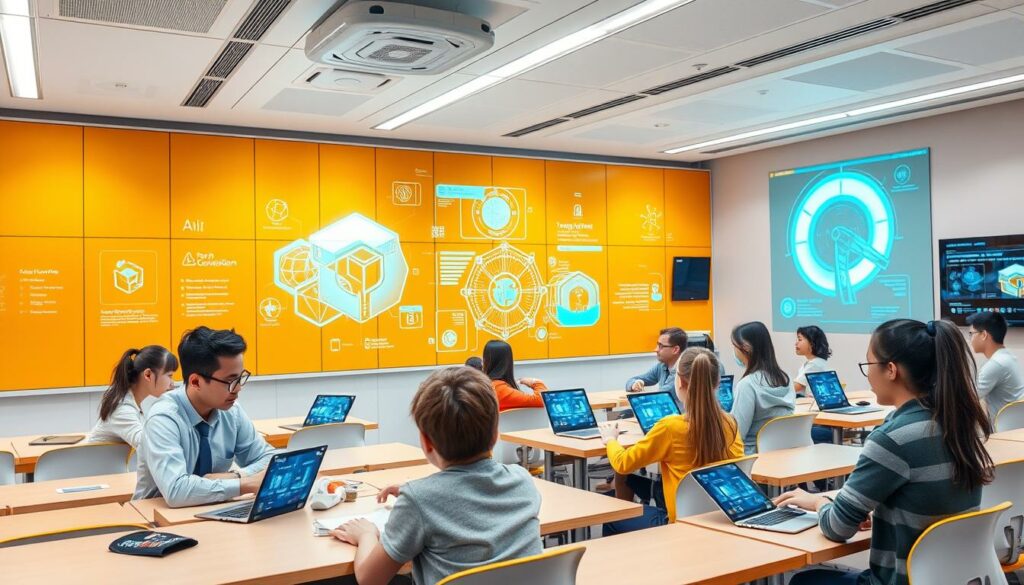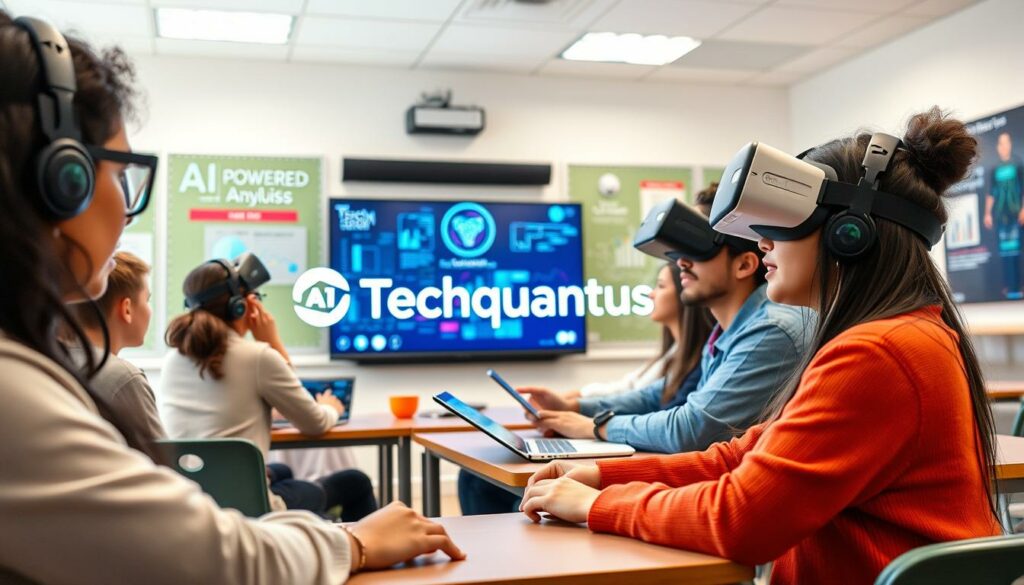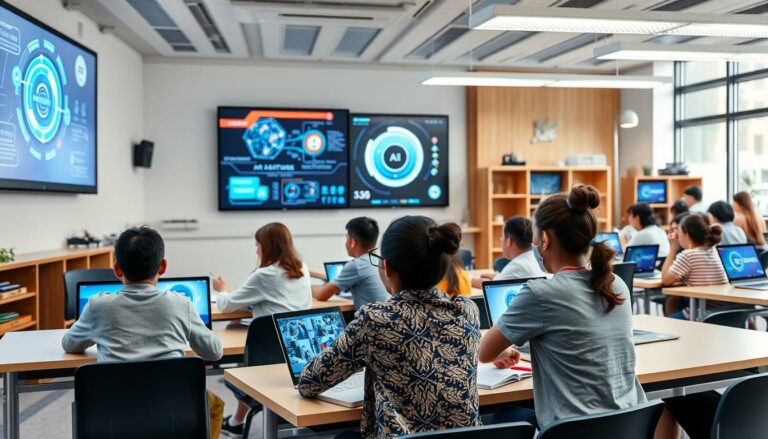Did you know over 80% of educators think AI can make learning better? AI is changing education, affecting how students learn and teachers teach. It’s making learning more engaging and improving results.
AI is changing education in big ways. Tools like ChatGPT help bridge the gap between old and young. They make learning fit what each student needs. EdTech is key in making learning fun, creative, and ongoing.
AI is making learning better for students and teachers alike. It gives teachers insights to make teaching more effective. For more on how AI is changing education, check out this piece on AI technology’s impact on intergenerational learning.
Key Takeaways
- AI is revolutionizing the educational landscape with personalized learning experiences.
- Data-driven insights help educators optimize teaching methods and curricula.
- AI tools facilitate nurturing family connections and educational bonding.
- Interactive learning environments keep students engaged and motivated.
- AI is essential in fostering continuous education and cognitive stimulation.
The Role of AI in Modern Education
AI is changing how we learn. It’s making traditional teaching better by adding new tech tools. These tools help design courses, manage tasks, and handle resources.
About 30% of teachers now use AI tools to make their work easier. This lets them spend more time with students. For example, ChatGPT helps families connect by sharing stories, making learning fun across generations.
AI changes how we interact in education. Grandparents say they feel closer to their grandkids thanks to ChatGPT. It helps them tell stories and talk, no matter where they are. This shows how AI makes learning and bonding easier.
AI also makes tasks like making content, managing emails, and understanding users easier. Schools use AI to work better, do less manual work, and improve learning for everyone.
| AI Application | Impact on Education |
|---|---|
| Curriculum Design | Customizes learning paths based on student data |
| Administrative Tasks | Automates scheduling and resource management |
| Communication Tools | Enhances interaction among students and families |
| Engagement Strategies | Promotes interaction through storytelling and discussion |
Understanding AI-Powered Learning Tools
AI-powered learning tools change how we learn by offering experiences tailored to each student’s needs. They include adaptive learning platforms and intelligent tutoring systems. These tools aim to improve learning outcomes.
Adaptive learning platforms use data to change content on the fly. This means each student gets lessons that match their learning speed. Tools like DreamBox Learning and Smart Sparrow track student progress and adjust lessons. This helps students understand better.
Intelligent tutoring systems, like Carnegie Learning and Knewton, give help that feels like a personal teacher. These tools boost students’ confidence and help them do better in school.
Here’s a table that shows how different AI tools work and how well they do:
| Tool | Category | Key Functionality | Effectiveness |
|---|---|---|---|
| DreamBox Learning | Adaptive Learning | Real-time learning path adaptation | Increases student engagement by 30% |
| Carnegie Learning | Intelligent Tutoring | Personalized feedback and support | Improves math scores by 20% |
| Knewton | Data-Driven Insights | Customizable content recommendations | Enhances retention rates by 25% |
As schools use these AI tools, we see better student results. AI makes learning smoother and helps teachers and students succeed more in today’s changing world.
Benefits of AI in Education
Artificial intelligence in education opens up many ways to make learning better and more effective. It brings big advantages that help students in many ways, making school better for everyone.
Personalized Learning Experiences
AI makes learning personal for each student. It changes the content to fit what each student needs and how they learn best. By looking at data, AI finds out what students are good at and where they need help.
This makes learning more fun and helps students understand better. It shows how AI can really improve education.
Data-Driven Insights for Educators
Teachers get a lot from the data AI provides. This data shows where students might be having trouble, so teachers can help them better. Schools are starting to use AI tools, thanks to government support.
This helps teachers make better plans based on real data, not just guesses. With AI, teachers can tailor their teaching to what each student needs.
Using AI in schools is making learning more effective and open to everyone. Check out how AI can change education and see the difference it makes.
AI Learning Platforms and Their Features
AI learning platforms have changed how we learn by using advanced tech to make content engaging. They offer features that help different types of learners, making them key in today’s classrooms.
Many AI learning platforms are known for their special abilities:
| Platform | Key Features | Target Audience |
|---|---|---|
| TalentLMS | Fast content creation, virtual assistance, user engagement | Small to midsized businesses |
| Docebo | Personalized learning paths, social learning integration | Corporate training |
| CYPHER Learning | Gamification, mobile learning capabilities | Schools and educational institutions |
| LearnUpon | Customizable reporting, learner assessments | All sectors |
These platforms use artificial intelligence to give learners personalized experiences. They change training to fit what each learner needs, track progress, and automate many education tasks. The perks of AI learning platforms include less manual work and ongoing feedback that keeps learners interested.
With features like quick content creation and courses tailored to user habits, these platforms cover a wide range of learning needs. From training on rules to helping new employees, AI is making education more effective. As AI gets better, these platforms will offer even more, promising a bright future for learning.
AI in Education: Enhancing Student Engagement
AI is changing education, making learning more engaging for students. Interactive learning and gamification are key in this change. They help students connect better with their studies, making learning fun and effective.
Interactive Learning Environments
Interactive learning is key to keeping students engaged. Teachers use technology to create spaces where students work together and take part actively. Tools like virtual simulations and quizzes make classes more lively.
Studies show that active learning improves critical thinking and helps students remember more. For more on how to help students learn on their own, check out this link.
Gamification and AI
Gamification makes learning fun by adding game elements. It uses students’ competitive nature to boost their interest. With leaderboards and rewards, students are more likely to take part.
This approach makes hard subjects easier and makes learning fun. It helps students feel a sense of achievement.
| Methodology | Description | Benefits |
|---|---|---|
| Interactive Learning | Utilizes technology to promote engagement through collaboration. | Enhances critical thinking and information retention. |
| Gamification | Incorporates game elements into educational activities. | Boosts motivation and makes learning enjoyable. |
The Future of AI in Education
The future of AI in education is set to change everything. Thanks to new tech, learning will get better and managing schools will be easier. We’ll see things like virtual reality learning and tools that understand natural language, changing how we get and understand information.
Innovations on the Horizon
Advanced AI tools for testing are coming soon. They’ll help teachers see how students are doing right away. This way, teachers can help students more by focusing on their weak spots. AI will also make learning fun with interactive simulations that feel real.
AI could also make learning more personal. It can adjust to how each student learns best. This means education could be more effective for everyone. As AI grows, it could help all students get the same chance to succeed.

Here’s a look at how AI will change education, with its good and bad sides:
| Benefit | Challenge |
|---|---|
| Enhanced personalized learning experiences | Need for teacher training on AI tools |
| Data-driven insights for student performance | Ethical concerns regarding data privacy |
| Increased engagement through interactive content | Disparities in access to technology |
| Improved assessments through real-time analytics | Resistance to change from traditional methods |
As AI changes education, it’s important to keep up with the latest. The mix of tech and learning could make school better for everyone. It could make learning more fun, open to all, and more effective for the future.
Challenges of Implementing AI in Education
Adding AI to schools faces many hurdles. One big issue is resistance from educators. Teachers worry that AI might speed past human teaching or weaken the bond between teachers and students.
Privacy is another big worry. Keeping student data safe is crucial, but some schools don’t have the right systems to protect it. These AI implementation issues slow down adoption and worry parents and teachers.
Money is also a big problem. Schools need a lot of money to use advanced AI, but they often don’t have it. They usually spend on basic needs instead of new tech.
Some schools have tried AI and done well, but others have hit roadblocks. They found it hard to set up AI because it needs a lot of training for staff and students. These stories show how tough it is to bring AI into schools.
| Challenge | Description |
|---|---|
| Resistance from Educators | Many teachers fear AI will replace traditional teaching methods, leading to hesitance in integrating technology into classrooms. |
| Privacy Concerns | Managing and securing student data is critical, yet many institutions lack the infrastructure to effectively protect this information. |
| Financial Constraints | Budget limitations hinder schools from investing in necessary AI tools and training, creating disparities in technology access. |
| Implementation Complexity | Integration of AI tools can be overwhelming, requiring training and adaptation that schools may not be prepared to handle. |
Case Studies of Successful AI Integration in Classrooms
Many educators look for case studies AI education to see how AI works well in classrooms. These examples show how successful AI integration leads to better learning. For instance, Sandia National Laboratories and Arizona State University got a big $17 million award to improve photonic technologies with AI. This shows AI’s power to change complex systems, which can also change how we teach.
Studies show AI’s good effects on learning. Chourasia et al. (2022) talked about the benefits and challenges of using AI in schools worldwide. They stressed the need to understand AI’s big impact on education. Bansal et al. (2024) looked at how ChatGPT changes how students use AI, making them think more critically and creatively.
Kalla et al. (2023) looked at how ChatGPT changes learning in different subjects. It shows the tool’s ability to make learning better. McTighe and Silver (2020) shared insights on teaching methods that focus on deeper learning, using AI to engage students.
- Sandia’s National Security Photonics Center has over 50 patents, showing AI’s role in innovation.
- The SWAP Hub helps with making microelectronics prototypes, affecting how we learn about advanced tech.
- Using AI well creates a culture of learning on your own, as seen by Karlsson and Kjisik (2011).
These successful AI integration examples show a trend to make education better. They help us see how AI can make learning more engaging and support teachers in creating better learning spaces.

AI-Powered Education and Ethical Considerations
Artificial intelligence is changing education, bringing up ethical questions. It’s crucial to tackle these issues to make learning fair and open for everyone. Some students might get more AI benefits than others because of unequal access to these tools.
AI can also carry biases if it’s trained on biased data. This can make stereotypes worse or keep inequalities going. It’s important to check the data used to train AI to avoid these problems. Teachers need to make sure AI tools don’t unfairly affect certain groups of students.
There are also worries about how AI watches over students. While it can help students learn better, it can also invade their privacy. Setting clear rules for using AI in schools can help protect students’ rights and privacy.
In conclusion, using AI in education needs careful thought. By focusing on ethical issues, we can make education better for everyone. This means making it fair, open, and effective for all students.
Conclusion
As we conclude our look at AI in education, it’s clear AI is changing how students learn and teachers teach. We’ve seen how AI offers personalized learning and deep insights for teachers. These changes have made education better and improved student results, creating a more engaging classroom.
But, there are challenges with using AI in schools too. Issues like ethics, privacy, and being ready for new tech are important. When thinking about AI’s future in education, remember to see both the good and the hard parts.
AI’s effect on education is just the start of something big. As technology gets better, getting involved with AI tools is key. This way, you help make education better, fairer, and more effective for the future.
FAQ
How is AI transforming the educational experience?
AI is changing education by offering personalized learning, interactive classes, and insights from data. This makes learning more engaging for students and helps teachers teach better.
What kinds of AI-powered learning tools are available?
AI has tools like adaptive learning platforms, smart tutoring systems, and tests. These tools meet students’ unique learning needs and help improve their results.
What are the main benefits of using AI in education?
AI makes learning personalized, helps teachers understand students better, boosts student interest, and changes how content is delivered.
Can you name some popular AI learning platforms?
Famous AI-enhanced platforms include Khan Academy and Coursera. They offer interactive learning, track progress, and are easy to use.
How does AI enhance student engagement in the classroom?
AI makes learning fun with interactive tools, games, and content that students like. This keeps them more involved in their studies.
What are some future trends in AI in education?
Future trends include better virtual reality for learning, smarter language tools, and more detailed tests. These will make learning even better.
What challenges are associated with the implementation of AI in education?
Challenges include some teachers being hesitant, worries about student data privacy, and the need for more resources for AI.
What are some examples of successful AI integration in classrooms?
Many schools and districts have successfully used AI. This has led to better student grades and more efficient teachers.
What ethical considerations should be taken into account when using AI in education?
Important ethical issues include making sure all students can use AI, fixing biases in AI, and protecting privacy in schools.
Source Links
- Oprah Winfrey Gathers AI Powerhouses For TV Special
- IBC2024: AI set to shine at the RAI – Installation
- Embracing the Future with ChatGPT for Grandma and Grandpa
- Bring Your Organizational Data to Azure AI Services with Microsoft Graph
- AI Security and Automation Saw $1.8 Million Reduction in Average Data Breach Costs in 2024
- Where exactly are all the AI jobs? • Oregon Capital Chronicle
- School introduces UK’s first ‘teacherless’ AI classroom
- ‘Get to know your enemy.’ How Hollywood workers are learning to use AI
- Revolutionizing education through school-based healthcare
- Which AI Stocks Are Expected to Soar in 2025
- Discover Top 10 Platforms For Learning Al In 2024| BCM
- Team-Based Questioning Battles in Construction and Building Engineering Educational Environments: A Useful Tool for Engaging Active Learning in the Classroom
- What matters in advancing self-directed learning – Community College Daily
- Imitative AI and Mediocre Education
- AI for everyone: your interactive guide to Pakistan’s AI policy | The Express Tribune
- Sandia National Labs-led Team Combines Integrated Photonics And Light-wave Frequency For New Approach to Quantum Processing
- Dimensionality and the Four-Dimensional Learner
- Investing in Generative AI: Is It a Smart Move?
- Overarching Narrative on Artificial Intelligence – ICC – International Chamber of Commerce
- The Future of IT: Predictions for the Next Decade
- How AI and IoT are Driving Innovation in IT
- The Revolution of Modern Payment Apps: Security and Ease to Use
- AI’s Impact on Second-Hand Marketplaces
- How to Use Blockchain for Secure Transactions


